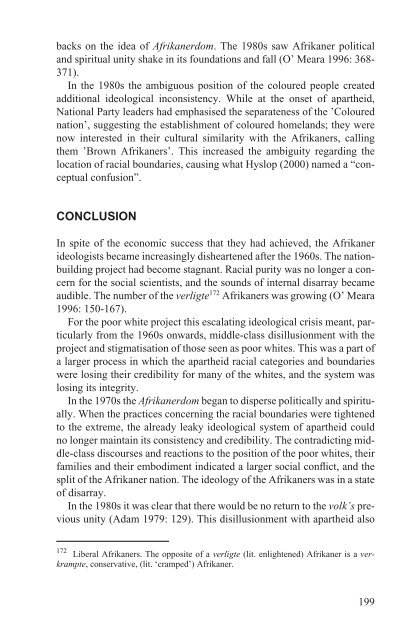The Making of a Good White - E-thesis - Helsinki.fi
The Making of a Good White - E-thesis - Helsinki.fi
The Making of a Good White - E-thesis - Helsinki.fi
Create successful ePaper yourself
Turn your PDF publications into a flip-book with our unique Google optimized e-Paper software.
acks on the idea <strong>of</strong> Afrikanerdom. <strong>The</strong> 1980s saw Afrikaner political<br />
and spiritual unity shake in its foundations and fall (O’ Meara 1996: 368-<br />
371).<br />
In the 1980s the ambiguous position <strong>of</strong> the coloured people created<br />
additional ideological inconsistency. While at the onset <strong>of</strong> apartheid,<br />
National Party leaders had emphasised the separateness <strong>of</strong> the ’Coloured<br />
nation’, suggesting the establishment <strong>of</strong> coloured homelands; they were<br />
now interested in their cultural similarity with the Afrikaners, calling<br />
them ’Brown Afrikaners’. This increased the ambiguity regarding the<br />
location <strong>of</strong> racial boundaries, causing what Hyslop (2000) named a “conceptual<br />
confusion”.<br />
CONCLUSION<br />
In spite <strong>of</strong> the economic success that they had achieved, the Afrikaner<br />
ideologists became increasingly disheartened after the 1960s. <strong>The</strong> nationbuilding<br />
project had become stagnant. Racial purity was no longer a concern<br />
for the social scientists, and the sounds <strong>of</strong> internal disarray became<br />
audible. <strong>The</strong> number <strong>of</strong> the verligte 172 Afrikaners was growing (O’ Meara<br />
1996: 150-167).<br />
For the poor white project this escalating ideological crisis meant, particularly<br />
from the 1960s onwards, middle-class disillusionment with the<br />
project and stigmatisation <strong>of</strong> those seen as poor whites. This was a part <strong>of</strong><br />
a larger process in which the apartheid racial categories and boundaries<br />
were losing their credibility for many <strong>of</strong> the whites, and the system was<br />
losing its integrity.<br />
In the 1970s the Afrikanerdom began to disperse politically and spiritually.<br />
When the practices concerning the racial boundaries were tightened<br />
to the extreme, the already leaky ideological system <strong>of</strong> apartheid could<br />
no longer maintain its consistency and credibility. <strong>The</strong> contradicting middle-class<br />
discourses and reactions to the position <strong>of</strong> the poor whites, their<br />
families and their embodiment indicated a larger social conflict, and the<br />
split <strong>of</strong> the Afrikaner nation. <strong>The</strong> ideology <strong>of</strong> the Afrikaners was in a state<br />
<strong>of</strong> disarray.<br />
In the 1980s it was clear that there would be no return to the volk’s previous<br />
unity (Adam 1979: 129). This disillusionment with apartheid also<br />
172 Liberal Afrikaners. <strong>The</strong> opposite <strong>of</strong> a verligte (lit. enlightened) Afrikaner is a verkrampte,<br />
conservative, (lit. ‘cramped’) Afrikaner.<br />
199
















